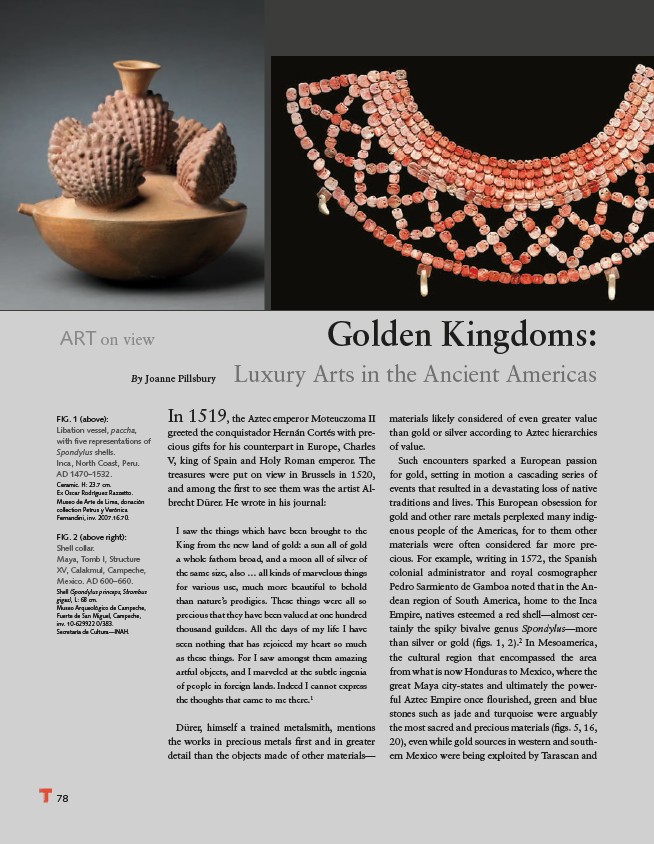
ART on view
FIG. 1 (above):
Libation vessel, paccha,
with fi ve representations of
Spondylus shells.
Inca, North Coast, Peru.
AD 1470–1532.
Ceramic. H: 23.7 cm.
Ex Oscar Rodríguez Razzetto.
Museo de Arte de Lima, donación
collection Petrus y Verónica
Fernandini, inv. 2007.16.70.
FIG. 2 (above right):
Shell collar.
Maya, Tomb I, Structure
XV, Calakmul, Campeche,
Mexico. AD 600–660.
Shell (Spondylus princeps, Strombus
gigas), L: 68 cm.
Museo Arqueológico de Campeche,
Fuerte de San Miguel, Campeche,
inv. 10-629922 0/383.
Secretaría de Cultura—INAH.
78
Golden Kingdoms:
Luxury Arts in the Ancient Americas
In 1519, the Aztec emperor Moteuczoma II
greeted the conquistador Hernán Cortés with precious
gifts for his counterpart in Europe, Charles
V, king of Spain and Holy Roman emperor. The
treasures were put on view in Brussels in 1520,
and among the fi rst to see them was the artist Albrecht
Dürer. He wrote in his journal:
I saw the things which have been brought to the
King from the new land of gold: a sun all of gold
a whole fathom broad, and a moon all of silver of
the same size, also … all kinds of marvelous things
for various use, much more beautiful to behold
than nature’s prodigies. These things were all so
precious that they have been valued at one hundred
thousand guilders. All the days of my life I have
seen nothing that has rejoiced my heart so much
as these things. For I saw amongst them amazing
artful objects, and I marveled at the subtle ingenia
of people in foreign lands. Indeed I cannot express
the thoughts that came to me there.1
Dürer, himself a trained metalsmith, mentions
the works in precious metals fi rst and in greater
detail than the objects made of other materials—
materials likely considered of even greater value
than gold or silver according to Aztec hierarchies
of value.
Such encounters sparked a European passion
for gold, setting in motion a cascading series of
events that resulted in a devastating loss of native
traditions and lives. This European obsession for
gold and other rare metals perplexed many indigenous
people of the Americas, for to them other
materials were often considered far more precious.
For example, writing in 1572, the Spanish
colonial administrator and royal cosmographer
Pedro Sarmiento de Gamboa noted that in the Andean
region of South America, home to the Inca
Empire, natives esteemed a red shell—almost certainly
the spiky bivalve genus Spondylus—more
than silver or gold (fi gs. 1, 2).2 In Mesoamerica,
the cultural region that encompassed the area
from what is now Honduras to Mexico, where the
great Maya city-states and ultimately the powerful
Aztec Empire once fl ourished, green and blue
stones such as jade and turquoise were arguably
the most sacred and precious materials (fi gs. 5, 16,
20), even while gold sources in western and southern
Mexico were being exploited by Tarascan and
By Joanne Pillsbury